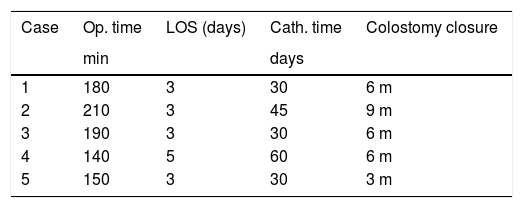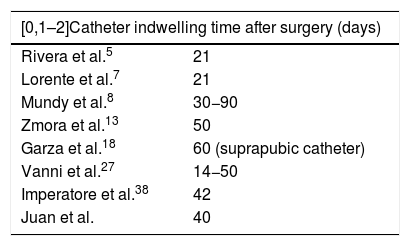Rectal injury is a rare complication after extraperitoneal laparoscopic radical prostatectomy. The development of rectourethral fistulas (URF) from rectal injuries is one of the most feared and of more complex resolution in urology.
Material and methodsBetween 2013 and 2020 we have operated on a total of 5 patients with URF after extraperitoneal endoscopic radical prostatectomy through a perineal access using the interposition of biological material. All fistulas had a diameter of less than 6 mm at endoscopy and were less than 6 cm apart from the anal margin.
ResultsThe mean age of the patients was 64 years old. All patients had a previous bowel and urinary diversion for at least 3 months. Under general anesthesia and with the patient in a forced lithotomy position, fistulorraphy and interposition of biological material of porcine origin (lyophilized porcine dermis [Permacol®]) were performed through a perineal access. Mean operative time was 174 min (140–210). Most patients were discharged on the third postoperative day. The bladder catheter was left in place for a mean of 40 days (30–60). Prior to its removal, cystography and a Gastrografin® barium enema were performed, showing resolution of the fistula in all cases.
ConclusionsThe interposition of biological material from porcine dermis through perineal approach is a safe alternative with good results in patients submitted to urethrorectal fistulorraphy after radical prostatectomy.
La lesión rectal es una complicación infrecuente de la prostatectomía radical laparoscópica extraperitoneal. El desarrollo de fístulas uretrorrectales (FUR), a partir de lesiones rectales, resulta uno de los problemas más temidos y de más compleja resolución en urología.
Material y métodosEntre 2013 y 2020 hemos intervenido a un total de cinco pacientes con FUR tras prostatectomía radical endoscópica extraperitoneal, mediante un abordaje perineal utilizando la interposición de material biológico. Todas las fístulas presentaron un diámetro menor de 6 mm en la endoscopia y se encontraban a menos de 6 cm del margen anal.
ResultadosLa media de edad de los pacientes fue 64 años. Todos los pacientes llevaban al menos tres meses de derivación intestinal y urinaria previas. Bajo anestesia general, y con el paciente en posición de litotomía forzada mediante un acceso perineal, se realizó fistulorrafia e interposición de material biológico de origen porcino (dermis porcina liofilizada [Permacol®, Medtronic]). La duración media de la cirugía fue de 174 min (140–210). La mayoría de los pacientes fueron dados de alta al tercer día postoperatorio. La sonda vesical se mantuvo una media de 40 días (30–60). Previa a la retirada de la misma, se realizó cistografía y enema opaco con Gastrografin®, que mostró resolución de la fístula en todos los casos.
ConclusionesLa interposición de material biológico procedente de dermis porcina mediante abordaje perineal es una alternativa segura y con buenos resultados en pacientes sometidos a fistulorrafia uretrorrectal tras prostatectomía radical.


















